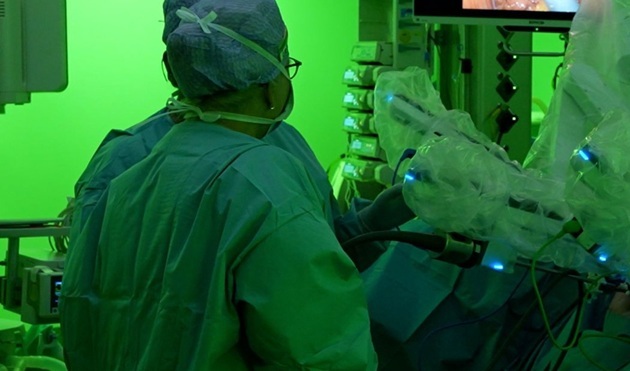Electrical Grounding Technique Improves NICU Outcomes
|
By HospiMedica International staff writers Posted on 15 Aug 2017 |

Image: A new study suggests electrical grounding improves vagal tone in neonates in the NICU (Photo courtesy of PSU).
A new study suggests that grounding can moderate preterm infants' electromagnetic exposure in the neonatal intensive care unit (NICU), improving vagal tone (VT).
Researchers at Penn State College of Medicine (PSU; Hershey, PA, USA) conducted a study of electric field strengths in the NICU environment by measuring environmental magnetic flux density (MFD) in and around neonatal incubators. They also wished to determine if the resulting skin potential correlated with VT, and to identify if connecting an infant to an electrical ground would reduce skin potential and improve VT. Grounding was achieved via a patch electrode and wire that extended to a wall outlet.
The researchers measured skin potential in 26 infants and heart rate variability in 20 of these infants before, during, and after grounding, with VT represented by the high-frequency power of heart rate variability. The results revealed that while background MFD in the NICU was below 0.5 mG, it ranged between 1.5 and 12.7 mG in the incubator. A pre-grounding 60-Hz oscillating potential was recorded on the skin of all infants, which was inversely correlated with VT. Following grounding, a voltage drop of 95% occurred, with VT increasing by 67%. The study was published in the August 2017 issue of Neonatology.
“Preterm babies in the NICU have a lot of health challenges due to the immaturity of their lungs, of their bowel, and of all their organs, so we decided to look at how electrical grounding could help improve vagal tone and mitigate some of those challenges,” said professor of pediatrics Charles Palmer, MD. “What we can conclude is that a baby's autonomic nervous system is able to sense the electrical environment and it seems as though a baby is more relaxed when grounded.”
“When tied to our previous work, which found that vagal tone was an important risk factor for necrotizing enterocolitis, this new finding may offer an opportunity to protect babies even further,” concluded Professor Palmer. “If more research confirms our results, it could mean, for example, redesigning incubators to ground babies and cancel out the electrical field.”
VT represents an index for the functional state of the entire parasympathetic nervous system (PSNS), as it regulates the resting state of the majority of the body's internal organ systems, such as the heart, lungs, eyes, glands and digestive tract. Due to the unconscious regulatory nature of the PSNS, vagal activity is continuous, chronic, and passive. VT is measured by analyzing heart rate variability between inhalation and exhalation, otherwise known as respiratory sinus arrhythmia (RSA). Low VT is a marker of vulnerability to stress.
Related Links:
Penn State College of Medicine
Researchers at Penn State College of Medicine (PSU; Hershey, PA, USA) conducted a study of electric field strengths in the NICU environment by measuring environmental magnetic flux density (MFD) in and around neonatal incubators. They also wished to determine if the resulting skin potential correlated with VT, and to identify if connecting an infant to an electrical ground would reduce skin potential and improve VT. Grounding was achieved via a patch electrode and wire that extended to a wall outlet.
The researchers measured skin potential in 26 infants and heart rate variability in 20 of these infants before, during, and after grounding, with VT represented by the high-frequency power of heart rate variability. The results revealed that while background MFD in the NICU was below 0.5 mG, it ranged between 1.5 and 12.7 mG in the incubator. A pre-grounding 60-Hz oscillating potential was recorded on the skin of all infants, which was inversely correlated with VT. Following grounding, a voltage drop of 95% occurred, with VT increasing by 67%. The study was published in the August 2017 issue of Neonatology.
“Preterm babies in the NICU have a lot of health challenges due to the immaturity of their lungs, of their bowel, and of all their organs, so we decided to look at how electrical grounding could help improve vagal tone and mitigate some of those challenges,” said professor of pediatrics Charles Palmer, MD. “What we can conclude is that a baby's autonomic nervous system is able to sense the electrical environment and it seems as though a baby is more relaxed when grounded.”
“When tied to our previous work, which found that vagal tone was an important risk factor for necrotizing enterocolitis, this new finding may offer an opportunity to protect babies even further,” concluded Professor Palmer. “If more research confirms our results, it could mean, for example, redesigning incubators to ground babies and cancel out the electrical field.”
VT represents an index for the functional state of the entire parasympathetic nervous system (PSNS), as it regulates the resting state of the majority of the body's internal organ systems, such as the heart, lungs, eyes, glands and digestive tract. Due to the unconscious regulatory nature of the PSNS, vagal activity is continuous, chronic, and passive. VT is measured by analyzing heart rate variability between inhalation and exhalation, otherwise known as respiratory sinus arrhythmia (RSA). Low VT is a marker of vulnerability to stress.
Related Links:
Penn State College of Medicine
Latest Critical Care News
- Soft Robots Could Donate Their Heart to Humans
- Bioadhesive Strategy Prevents Fibrosis Around Device Implants on Peripheral Nerves
- Miniature Non-Invasive Robotic Catheters to Improve Infertility Treatments
- Stick-On Patch Monitors Baby's Movements In Utero
- EEG-Based AI Technology Accurately Diagnoses Alzheimer’s and Dementia
- Robot Lymphatic System Paves Way for Self-Powered Wearables and Machines
- Focused Ultrasound Technique Successfully Treats Pediatric Brain Cancer
- Nasal Drops Fight Brain Tumors Noninvasively
- AI Helps Optimize Therapy Selection and Dosing for Septic Shock
- Glowing Bacteria ‘Pills’ for Detecting Gut Diseases Could Eliminate Colonoscopies
- Skin-Permeable Polymer Patch Delivers Insulin Non-Invasively Through Skin
- Nanogel Technology Almost 100% Effective in Destroying Drug-Resistant Bacteria Within Hours
- Wearable Ultrasound Sensor Delivers Noninvasive Treatment Without Surgery
- Gel-Free ECG System to Transform Heart Health Diagnosis
- Biodegradable Patch Repairs Damaged Tissue After Heart Attack
- Magnetically Guided Microrobots to Enable Targeted Drug Delivery

Channels
Surgical Techniques
view channel
Minimally Invasive Surgery Proven Safe and Effective for Complex ‘Whipple’ Procedure
Tumors of the pancreatic head often require a highly complex operation known as pancreatoduodenectomy or the Whipple procedure. This surgery involves removing multiple structures and creating several internal... Read more
Catheter-Based Procedures Offer Less Invasive Option for Treatment of Valvular Disease
Valvular heart disease, caused by tight or leaky valves between heart chambers, affects up to 10% of older adults and leads to more than 120,000 deaths globally each year. Traditional open-heart surgery... Read morePatient Care
view channel
Revolutionary Automatic IV-Line Flushing Device to Enhance Infusion Care
More than 80% of in-hospital patients receive intravenous (IV) therapy. Every dose of IV medicine delivered in a small volume (<250 mL) infusion bag should be followed by subsequent flushing to ensure... Read more
VR Training Tool Combats Contamination of Portable Medical Equipment
Healthcare-associated infections (HAIs) impact one in every 31 patients, cause nearly 100,000 deaths each year, and cost USD 28.4 billion in direct medical expenses. Notably, up to 75% of these infections... Read more
Portable Biosensor Platform to Reduce Hospital-Acquired Infections
Approximately 4 million patients in the European Union acquire healthcare-associated infections (HAIs) or nosocomial infections each year, with around 37,000 deaths directly resulting from these infections,... Read moreFirst-Of-Its-Kind Portable Germicidal Light Technology Disinfects High-Touch Clinical Surfaces in Seconds
Reducing healthcare-acquired infections (HAIs) remains a pressing issue within global healthcare systems. In the United States alone, 1.7 million patients contract HAIs annually, leading to approximately... Read moreHealth IT
view channel
EMR-Based Tool Predicts Graft Failure After Kidney Transplant
Kidney transplantation offers patients with end-stage kidney disease longer survival and better quality of life than dialysis, yet graft failure remains a major challenge. Although a successful transplant... Read more
Printable Molecule-Selective Nanoparticles Enable Mass Production of Wearable Biosensors
The future of medicine is likely to focus on the personalization of healthcare—understanding exactly what an individual requires and delivering the appropriate combination of nutrients, metabolites, and... Read moreBusiness
view channel
Philips and Masimo Partner to Advance Patient Monitoring Measurement Technologies
Royal Philips (Amsterdam, Netherlands) and Masimo (Irvine, California, USA) have renewed their multi-year strategic collaboration, combining Philips’ expertise in patient monitoring with Masimo’s noninvasive... Read more
B. Braun Acquires Digital Microsurgery Company True Digital Surgery
The high-end microsurgery market in neurosurgery, spine, and ENT is undergoing a significant transformation. Traditional analog microscopes are giving way to digital exoscopes, which provide improved visualization,... Read more
CMEF 2025 to Promote Holistic and High-Quality Development of Medical and Health Industry
The 92nd China International Medical Equipment Fair (CMEF 2025) Autumn Exhibition is scheduled to be held from September 26 to 29 at the China Import and Export Fair Complex (Canton Fair Complex) in Guangzhou.... Read more













